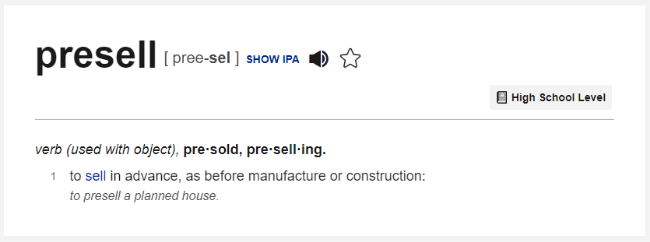13+ Effective Ways To Promote Online Courses
Are you struggling to attract an audience for your online course?
Creating your course is only one piece of the puzzle and unfortunately the old mantra of ‘build it and they will come’ doesn’t work.
But, with the right strategy and tactics in place, you can finally start to see some traction with your online course.
In this post, you’ll learn how to promote your online course.
Some of these tactics will help you drive traffic. Others will help you increase conversions.
The result? More traffic and sales.
Let’s dive right in:
1. Understand your audience and create student personas
When most people start online marketing, we think website traffic is everything. You know – I wish I can get as many visits as CNN or BBC or any of those big websites.
Well, it’s good to aim high but how much is your traffic worth? Are you connecting with the people who need your online course, or are you just driving a load of traffic to your site hoping something (or someone) will stick?
Before creating your online course, you should have a clear picture of your target audience. And you should paint this picture based on real-world data, and not the vague assumptions you have in your noggin.
Otherwise, you will end up creating an online course that nobody buys, and all the marketing strategies on this planet won’t matter. I don’t mean to be harsh, rude, or anything – it’s just the truth.
So, spend a ton of time researching your target audience and creating your ideal student personas.
Have answers to simple questions such as:
- Where do they live?
- What do they want to accomplish?
- Can your ideal student afford your course?
- What are their greatest pain points?
- What’s their age bracket?
- What’s their lingo?
- Are they already buying from a competitor?
- And so on
The easiest way to learn more about your target audience is to ask. Don’t be scared to use surveys on your website and social media to collect more data about your audience.
Ask and keep asking. Trust me, most of your readers are more than eager to tell you exactly what they need. After that, use the answers to create and refine your course.
Learn all you can about your audience so you can create a successful online course that they need and are ready to buy.
It would be a shame to spend a lot of time and money to create multiple courses that nobody wants. Do your research beforehand, which leads us to the next point.
2. Presell your online course

“Build it and they will come,” they say. Sadly, this approach doesn’t work for most people, especially online instructors.
You have spent weeks developing your brilliant course and even gone through the rigorous shenanigans that come with a launch.
Now, you’re just waiting for potential students to pour in and hand you money on a silver platter.
But nobody shows up, or the numbers are a far cry from appealing. You’re stuck wondering what happened. After all, you did everything right. Or did you?
After defining your target audience, it’s important to create anticipation and excitement before developing your course.
Are people interested in your online course? Have you addressed their pain points? Will anybody pay a cent for your course?
This tactic might seem counterproductive at first but it’s wise to determine if people want what you’re creating.
Preselling allows you to measure the demand for your online course. It is also a great opportunity to collect feedback that you can use to improve the said course.
You can offer discounts or early bird pricing (more about this later) to attract potential students. Or, you can host a live webinar covering the basic tenets of your course.
It’s better to invest time figuring out whether there is demand for your product than spend a ton of resources creating a course that nobody wants.
Preselling works wonders, especially for small businesses with budget constraints. The approach allows you to build momentum for your course long before launch.
3. Niche down
It is no secret that the internet is a brutal place. There is always stiff competition no matter how good of a marketing strategy you implement.
Countless other tutors are offering exactly the course you’re looking to promote. Here’s a quick example.
If you go to Google and search “content marketing course,” you will get about 1.5 billion results. That’s a lot of competition mi amigo.
If you search for “content marketing course for dentists in Texas,” you will find about two million results, and most aren’t even about an actual course.
Do you see where I am going with this?
Instead of wasting time trying to compete with the entire World Wide Web, it pays to find a niche where you can compete favorably.
Don’t try to cover a broad topic in the hopes that someone will find your course. Instead, focus on a narrow niche where you stand out as an expert. It will be easier to promote your online course then.
4. Create content consistently

When we were researching this blog post, I stumbled upon a great article by Luisa Zhou, who – by the way – has perfected the art of selling online courses over the years.
How did I find her article? You guessed it right – via Google search. And how did she end up among the top search results?
Again, you guessed it right – she writes great content regularly. Google and other search engines love that, which is why they reward her with high rankings.
It’s quite an easy approach to implement.
Simply offer useful content around the topic of your course. You know, give potential students tidbits that – like magic – will eventually sway their decision, even if they were skeptical at first.
If you don’t have a blog, it’s time to start one. If, say, I’m interested in search engine optimization (SEO), I should regularly cover topics revolving around SEO on my blog.
Later on, I can sell an SEO course or something related.
The best part is your readers already trust you as an expert based on your articles. I mean, posting consistently on your blog allows you to establish authority over time.
Other than that, you can use the content from your blog posts in your course allowing you to kill two birds with the same stone like a boss.
Remember, you’re not writing blog posts to promote your online course explicitly. You’re creating content that is useful to your readers long before they join your course.
If you can’t write to save your life, hire a freelance writer for your blog. Your potential customers (aka students) will thank you later.
Aim to provide relevant content in every blog post you publish and worry not about the transactional value. You should aim at educating your readers first instead of going for the hard sell.
With due time, and with a proper call to action (CTA), readers will buy your course. That’s right; don’t try to force courses down their throats if you want to create a long-term business.
In other words, provide value using relevant content first and potential students will join your course later.
Plus you can always monetize your blog via other methods, which allows you to create multiple income streams without additional work.
As easy as A, B, C.
5. Offer a free mini course

Luke Bailey from Thinkific posted a brilliant article about creating mini-courses just the other day. It’s a splendid guide if you don’t know where to start.
But just to get you through the door (and avoid confusion), a mini course is a short and snappy online course that takes 90 minutes or less to complete.
Most online tutors use mini-courses for market validation or as lead magnets to get potential customers interested in their longer and more expensive courses down the road.
Think of mini-courses as “small steps” in your sales funnel.
Instead of offering students a long and pricey course upfront (which might send them scuttling away), offer them a free mini-course that covers the basics.
Later, after you’ve captured their email addresses and gauged their interest in your offer, you can upsell your longer and pricier courses.
Additionally, a free mini-course can help you to sweeten your deal, allowing you to sell more courses without breaking a sweat.
They are fast to produce, cheap, and can be used as an order bump. It’s quite a powerful tool to include in your marketing strategy.
Plus, students don’t have to pay a dime upfront since it is free.
Additionally, mini-courses are easier to digest meaning there are higher chances of potential customers converting into loyal and paying students. It goes without saying that mini-courses attract more leads than longer courses.
When done right, a mini course is a fantastic accessory for your course sales page. And don’t sweat the small stuff; you can use bits of your course content to create your mini-courses.
You can offer your free mini-course on your course sales page, social media profiles, or online course platforms.
6. Create “mother content”
Honestly, this is the first time I’ve heard about this concept but it’s really interesting. It’s quite effective, you know, just like all the mothers in the world 🙂
So, what is “mother content?”
“Mother content” is video content that you create and repurpose for different media and platforms. I hope that makes sense.
Create “mother content” that revolves around your course topic and share it on multiple social media platforms.
You can also create a transcript of the video and post the same as an article on your blog or website.
The point is you can reuse “mother content” over and over and in different formats to attract more students.
7. Add testimonials and reviews
Are you looking to market your online course? Let your alumni do it for you. After all, they have seen results from your online course, which means it’s a success.
Here’s how:
Encourage your former students to leave testimonials and reviews about your course. You can use your contact form, contact them directly via email or create accounts on sites such as Trustpilot.
Good reviews will help you garner more future students since they can see others are benefiting from your course.
This is exactly what Elna Cain does for her freelance writing course, WriteTo1K:

Most internet users trust recommendations (read, testimonials and reviews) when reviewing products to buy online. It’s called social proof.
If your website runs on WordPress, Lyn Wildwood has a splendid article on how to add testimonials on any page. Brilliant, right?
If you must, entice former students and promoters with a referral fee.
8. Use social media marketing strategies

Facebook is undoubtedly one of the most popular social media networks in the world. But that’s just one platform. Over four billion people use social media.
That’s a huge crowd!
Not everybody is a prospective student in this group but you can be sure that a decent chunk of your target audience hangs out on social media websites.
We urge you to join Facebook groups that are in tandem with your courses. On these pages, don’t be a bore, or worse, a spammer that eventually gets banned.
Instead, endeavor to provide real value by answering questions and participating in discussions. Don’t be that one person who posts links unless the group admin allows it.
On top of that, create a Facebook page dedicated to your online course. A Facebook page allows you to promote your course and run ads (which, btw, is not possible with a personal profile).
Once you master Facebook, take to Twitter, TikTok, LinkedIn, Pinterest, Quora, Reddit, Instagram, and everything else in between.
Remember, however, that it’s important to focus on one platform before investing resources in more channels.
Host live shows, post videos, and simply strive to create an online community and a social media presence without trying to sell your online course first.
In other words, focus on creating engagement instead of selling. Once you have people hooked to your brand, it becomes easy to sell your online courses.
Social media websites are mostly free unless you’re paying for ads, which makes this strategy one of the cheapest and easiest to implement.
Luisa (we mentioned her earlier) was quite successful in promoting her online courses via Facebook live. You can do the same, more so in a world that’s full of all kinds of social media platforms.
While at it, don’t forget to frequent forums where your students hang out. Again, don’t post spammy links. Instead, participate in the discussions and offer value by answering questions.
Also, create a course promotion video and post it on social media websites as well as video hosting sites such as YouTube or Vimeo.
If you have the funds, consider adding social media adverts to your digital marketing strategies.
You can learn more about social media marketing from our friends at Social Media Today or Social Media Examiner. Also, check out our post on the best social media agencies around.
9. Use online advertising

Do you want to get your online course in front of many people quickly? If that’s a yes, you should consider investing in paid advertising. Google Ads and Facebook Ads are good examples.
Facebook Ads, in particular, are relatively cheap and easy to implement. We don’t expect you to run into any problems down the line.
If you are using Google Ads, you’ll likely find that they can be a bit more expensive but they can convert well. Just make sure you have done proper keyword research beforehand so you can focus on the terms that your target audience uses to find your content.
Most ad networks allow you to pinpoint an exact location and fine-tune your ads depending on other demographics.
Of all marketing strategies on today’s list, online advertising offer you the quickest way to reach your audience and market your online course.
Along with Google and Facebook, consider investing in YouTube ads, especially if most of your course material consists of videos.
Keep in mind that paid ads will need significant financial investment to work. As you would expect, channeling just $10 to paid ads won’t do much, so prepare in advance.
10. Partner up
Digital marketing (as well as traditional offline marketing) doesn’t exist in a vacuum. Do you want to run a successful marketing campaign for your online course?
If so, you should consider partnering with bloggers and other online instructors with the same audience you want to attract. However, you don’t want to be in direct competition with your partner.
Directly approach bloggers and ask them to review your online course. Great reviews on reputable blogs will help you to gain traction quickly.
On top of that, ask to be a guest on their webinars and podcasts. When you get the chance, focus on adding value, and not promoting your course directly.
Toward the end of the show, you can ask listeners/viewers to follow a link to your course sales page, website, or social media profiles.
At the same time, don’t forget to start your own podcast or webinar to promote your online course. If you know a prominent influencer, don’t shy from inviting them to your show.
Additionally, partner with vloggers who are willing to post your promotional video on their YouTube channel. You can pay them or offer them other incentives such as a free course.
11. Use email marketing
Email marketing is one of the best digital marketing strategies ever invented. The pros far outweigh the cons.
It’s cheap and considerably easy to set up thanks to email marketing tools such as Moosend, Drip, and Omnisend, among others.
Other than that, email has a high return on investment (ROI). You can expect about $40 for every $1 you spend. That’s a 4,000% ROI for a strategy that you can automate easily.
Start with a lead magnet such as the free mini-course we mentioned earlier, an ebook, or software that is useful to your website visitors.
If your lead magnet is really good, you will quickly build an email list, which – in case you’re wondering – is a valuable asset as far as promoting your online courses go.
Afterward and when the time is right, you can send personalized emails to current and future students to create awareness around your online course.
For instance, let’s say your course takes a month to complete. You can send students follow-up emails asking for feedback, and testimonials.
Also, you can use email marketing to reach out to people who subscribed to your newsletter (thanks to the lead magnet) but never signed up for your course.
Additionally, you can use emails to share updates and sell more courses in the future. You can also offer exclusive discounts and offers to your email subscribers.
If that isn’t enough, you can even sell your course in bits as an email series. The possibilities are virtually limitless.
12. Utilize search engine optimization (SEO)
SEO is another powerful tactic to market online courses without the high costs involved with other strategies such as paid advertising campaigns.
To beginners, SEO might seem daunting but nothing can be further from the truth. It’s relatively easy, and you don’t need coding skills (although it might help).
However, keep in mind that SEO takes time to deliver results. Don’t expect to start ranking high in search engines overnight.
To craft an SEO strategy that works, you need to start with astute keyword research. It will help you to understand the terms that people use to find your content.
You’ll need the help of a keyword research tool such as SE Ranking, Mangools, or Google Keyword Planner.
Once you have your keywords, you must create useful content around your topic keeping in mind the search terms that people use to find you. Also, keep your content fresh.
After that, you need to focus on link building, i.e., obtaining natural links from high-profile websites within your niche. You can do this successfully using tactics such as guest blogging but never buy links.
There are many other ranking factors, but SEO is a huge topic that we can’t cover within the scope of today’s post.
13. Offer discounts and early bird pricing
We mentioned this earlier.
Offering discounts and early bird prices can greatly help you promote your online course without trying hard.
How many times have you bought a product because of discounted prices? You’re not alone – we’ve all probably done it several times.
Retailers know this and they have used the strategy for years. Online courses are not different. You can use discounts and early bird pricing to attract more students.
But instead of offering random discounts, plan your discounts for holidays such as Black Friday and Christmas.
You can offer early bird pricing to your email subscribers long before launching your course, which helps you to validate your idea, and make sales right off the bat.
Other quick tips for selling online courses include:
- Instead of building a website from scratch (you can always do this later), use online learning platforms such as Udemy.
- Start or speak at local events and meetup groups.
- Translate your course into more languages.
- Create an affiliate program for your students, bloggers, influencers, and other partners.
- Try the subscription model instead of one-off payments that might be too pricey for students.
- Buy Tweets or Facebook posts on Fiverr.
- Organize competitions, challenges, and giveaways.
- Offer a money-back guarantee.
- Advertise on TV and radio.
Final words
Selling online courses is a profitable venture. Sure, it takes a lot of hard work and persistence, but if you know the ropes, you can realize profits in a relatively short period.
As with any other business or product, you want to focus 100% on the needs of your students keeping in mind that word of mouth is als a powerful marketing tool.
We hope the above tips pointed you in the right direction as far as promoting your online course goes. If you liked reading the post, please share it on social media.
Finally, if you haven’t launched your course yet, you might find this comparison of the best online course platforms useful.
Related Reading: The Top eLearning Statistics You Need To Know.
Disclosure: If you buy through links on our site, we may make a commission. This helps to support the running of Startup Bonsai.
